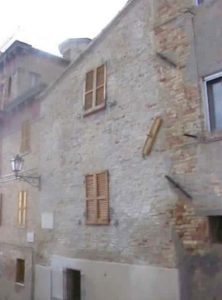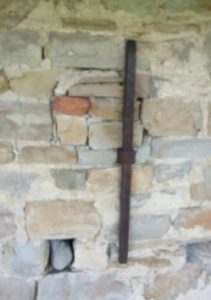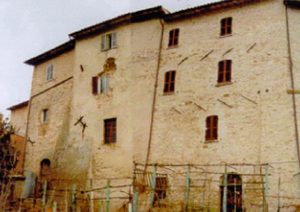The Ties That Bind
— Jackie Capurro

The first time that I visited my paternal cousins in the Abruzzo region in 1976, the houses of the four families that belonged to my relatives were interspersed among another 10-15 houses on a single gravel road, Colle Marrollo, that ran along the crest of a hill outside the village of Scerni, inland from the Adriatic seaside town of Vasto. As we walked along the road, I noticed what looked like very large metallic rods attached to the exterior surfaces of the walls of many houses. When I asked what they were, I was told that they held the house together in the event of an earthquake.
At first, I thought that they were trying to see how much their gullible young American cousin would believe, but they weren’t joking. In fact, not only do these metal tie-rods truly hold the houses together, they also allow the occupants to “pull the walls back together” if they shake loose! I was intrigued!
 Those who have followed the news of earthquakes in Central Italy in the past year will know that the regions of Abruzzo, Le Marche, Molise, and Umbria receive a high volume of earthquakes yearly. In the hilltop villages and towns in central Italy, many of the older houses, often dating back to the 1700s and 1800s, are built of masonry, roughly squared stone blocks set in lime mortar. Limestone and/or tuffa stone is most often used in their construction. Houses are often two or three stories high.
Those who have followed the news of earthquakes in Central Italy in the past year will know that the regions of Abruzzo, Le Marche, Molise, and Umbria receive a high volume of earthquakes yearly. In the hilltop villages and towns in central Italy, many of the older houses, often dating back to the 1700s and 1800s, are built of masonry, roughly squared stone blocks set in lime mortar. Limestone and/or tuffa stone is most often used in their construction. Houses are often two or three stories high.
A high proportion of these houses still have these traditional iron tie-rods which were first introduced in the 18th Century to tie together walls and floors that meet at right angles, to ensure better seismic performance. After the introduction of modern seismic codes (not until the 1980s!), many buildings have undergone further strengthening by more modern means, but these simple iron rods still do their duty.
 The rod that is seen from the outside serves as a “key” that is attached at both ends of a strong iron rod that runs the length of the house, through the masonry, and alongside the beams. This key can be rotated clockwise or counterclockwise to tighten or to loosen the walls and actually pull the walls into proper position if an earthquake has rattled them loose! Apparently, it is very important to distribute the ties in a regular pattern – irregular tie distribution may be a cause of worsened earthquake damage.
The rod that is seen from the outside serves as a “key” that is attached at both ends of a strong iron rod that runs the length of the house, through the masonry, and alongside the beams. This key can be rotated clockwise or counterclockwise to tighten or to loosen the walls and actually pull the walls into proper position if an earthquake has rattled them loose! Apparently, it is very important to distribute the ties in a regular pattern – irregular tie distribution may be a cause of worsened earthquake damage.
I’m relieved to be able to say that I never had occasion to see these rods in action during an earthquake during any of my visits to the region, but my relatives’ houses have remained standing for hundreds of years, so they must be doing something right!
